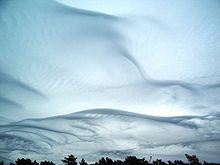- Undulatus Asperatus
-
 Undulatus Asperatus Wolkenformation über Missouri
Undulatus Asperatus Wolkenformation über Missouri Undulatus Asperatus Wolkenformation über Tallinn
Undulatus Asperatus Wolkenformation über Tallinn
Undulatus Asperatus oder alternativ Asperatus ist der Name einer seltenen, neu entdeckten Wolkenformation. Sie wurde 2009 als erste Wolkenformation seit Cirrus Intortus im Jahr 1951 zur Aufnahme in den Internationalen Wolkenatlas der World Meteorological Organization vorgeschlagen.[1] Der Name bedeutet übersetzt in etwa "aufgerauhte" oder "aufgewühlte Wellen".[2]
Margeret LeMone, Wolkenexpertin am National Center for Atmospheric Research, dokumentiert Undulati Asperati seit 30 Jahren und sieht sie als neue Wolkenformation an.[1] Am 20. Juni 2006 fotografierte Jane Wiggins eine Asperatus-Formation aus einem Bürogebäude in der Innenstadt von Cedar Rapids, Iowa, USA.[3][4] Im Jahr 2009 stieß Gavin Pretor-Pinney, Gründer der Cloud Appreciation Society, auf das Bild und begann durch die Royal Meteorological Society die Bekanntheit der Wolkenformation zu fördern.[2] Jane Wiggins Foto erschien am 4. Juni 2009 auf der Website von National Geographic.[3]
Die Wolkenformation ist am nächsten mit den Undulati verwandt.[2] Obwohl in der Erscheinung dunkel und sturmartig, lösen sie sich meist ohne Bildung eines Sturms auf.[5] Die unheilvoll aussehenden Wolken erscheinen besonders häufig in den Staaten der Great Plains der USA, oft in den Morgen- oder Mittagsstunden nach konvektiver Gewitteraktivität.[6] Die Royal Meteorological Society sammelt derzeit (Stand: Juni 2009) Nachweise der Arten von Wetterschemen, in denen sich Undulati Asperati bilden, um deren Bildung zu ergründen und danach zu entscheiden, ob sie sich von anderen Undulatuswolken unterscheiden.[2][5]
Einzelnachweise
- ↑ a b PICTURES: New Cloud Type Discovered?, National Geographic News. 3. Juni 2009.
- ↑ a b c d Asperatus: gathering storm to force new cloud name, The Guardian.
- ↑ a b Orlan Love: Photos: Look, up in the sky - it's a new cloud type!, Cedar Rapids Gazette. 5. Juni 2009.
- ↑ http://news.yahoo.com/s/ap/20090611/ap_on_re_us/us_new_cloud
- ↑ a b Luke Salkeld: The cloud with no name: Meteorologists campaign to classify unique 'Asperatus' clouds seen across the world, Daily Mail. 2. Juni 2009.
- ↑ http://www.meteorologynews.com/2009/06/06/new-cloud-type-discovered-undulus-asperatus
Weblinks
Wikimedia Foundation.

